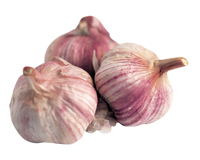
Features
Production
Research
Garlic producers need to be aware of nasty nematodes
need to be aware of nasty nematodes
April 23, 2008 By Marg Land
It started with a phone call to
Ontario plant pathologist Mike Celetti. A garlic producer on Prince
Edward Island was having a problem with his crop.
 It started with a phone call to Ontario plant pathologist Mike Celetti. A garlic producer on Prince Edward Island was having a problem with his crop. About 80 per cent of his plants had been lost, a victim of some form of bulb disease. The seed had originated in Ontario and had tested positive for bulb and stem nematode. What did Celetti know about bulb and stem nematode problems in Ontario garlic production?
It started with a phone call to Ontario plant pathologist Mike Celetti. A garlic producer on Prince Edward Island was having a problem with his crop. About 80 per cent of his plants had been lost, a victim of some form of bulb disease. The seed had originated in Ontario and had tested positive for bulb and stem nematode. What did Celetti know about bulb and stem nematode problems in Ontario garlic production?
“They’re not saying good things about seed from Ontario,” said Celetti, who works with the Ontario Ministry of Agriculture and Food (OMAF).
Bulb and stem nematode is nothing new to Ontario or even Canada. The first reported outbreak in Ontario occurred in 1957 and, since then, the pest has not caused severe problems for most of the province’s vegetable growers. Surveys of the Holland Marsh show very low populations of the pest in muck soils.
While it may be a regulated pest for the Canadian Food Inspection Agency (CFIA) for exports out of the country, there are no plans to have it regulated domestically.
“CFIA’s way of thinking is, it is found across the country and most industries are controlling it on their own,” said Celetti. “I don’t want this to be blown out of proportion. There are a lot of nasty pests out there that can shut the door on your industry a lot faster than this.”
Even so, he is urging Ontario’s garlic producers to become more aware of the problem and take steps to limit the spread of the pest through seed and control it in their own fields through crop management. He recently made a presentation on bulb and stem nematode to the Ontario Garlic Growers’ Association (OGGA) fall meeting.
Bulb and stem nematode can infect numerous crops, including onions, garlic, leeks, chives, shallots, peas, beets, carrots, celery, tomato, cucumber, tulip, hyacinth, narcissus, alfalfa, red clover, phlox and strawberries. Symptoms can include a swollen appearance at the base of the bulb and twisted and malformed leaves. Scales on older infected bulbs often split and appear swollen or bloated. Infected bulbs are also very susceptible to secondary bacterial or fungal infections.
“I saw some really bad samples this summer,” said John Zandstra, a professor and researcher with the Ontario Agricultural College’s Ridgetown campus.
But it is also possible for infection to occur with no symptoms at all. “You don’t in fact have to see any damage for the bulb to be infected,” explained Celetti. “This is the problem.
“The only way you’re going to know how extensive this is, is to have a survey of seed and soil.”
A soil test will show if the nematode is present in fields. According to Celetti, the pest can be controlled in the field through a three-to-four-year rotation with non-host crops. He believes the strain of bulb and stem nematode infecting garlic will not be attracted to cereal crops, such as rye or oats.
Celetti is also optimistic about the use of nematode-combating cover crops, such as Pearl millet 101, oilseed radish and hot Indian mustard. He is less supportive of fumigating, questioning whether its use is economical in garlic production.
On the seed side of the equation, tissue testing will show if cloves are infected.
“Do not use cloves as seed from infested fields,” said Celetti. “My advice is to start up a certification program, which can be expensive, but can pay off if you are serious about this industry.
“The seed is where you’re moving it around and, if you clean it (the seed) up, you’ll be ahead of the game.”
Growers might also want to consider a hot water seed treatment, a tricky process requiring a precise temperature balance so the nematode infection can be eliminated without killing the seed itself.
Celetti described a seed treatment, known as the California Treatment, which had the seed being immersed in 30 to 45˚C water for 30 to 45 minutes, followed by 20 minutes in 49˚C water and completed with 10 to 20 minutes in 18 to 22˚C water. Growers are urged to plant the cloves immediately.
In order to test the suitability of the hot water treatment, Celetti urged growers to try it in a small batch at first and plant the treated seed in a greenhouse to make sure the treatment doesn’t result in sterilized seed.
More information on bulb and stem nematode can be found in a fact sheet and the 2004/2005 Vegetable Production Recommendations, both available from OMAF. The Canadian Phytopathological Society also refers to the pest in “Diseases and Pests of Vegetable Crop.
Print this page